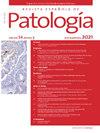Pulmonary angiostrongyliasis: Two cases of atypical manifestations of Angiostrongylus costaricensis in Guatemala
IF 0.5
Q4 Medicine
引用次数: 0
Abstract
Angiostrongyliasis, an infection caused by nematodes of the genus Angiostrongylus spp., includes nine species in the Americas. Angiostrongylus costaricensis induces eosinophilic enteritis in humans and has been documented in Guatemala. Humans are considered accidental or final hosts of A. costaricensis, as they do not release eggs or larvae in their faeces.
Most reported cases present with abdominal angiostrongyliasis (AA). Parasitic structures are difficult to identify in inflammatory lesions and larvae can occasionally migrate to extraintestinal organs. The gold standard for diagnosing A. costaricensis is histopathological analysis, confirmed by the identification of eggs, larvae in tissues, and/or adult worms in the vascular lumen.
In our department, two cases of A. costaricensis affecting pulmonary vessels were diagnosed histopathologically. Given the rarity of pulmonary involvement, the cases were consulted with Dr. Carlos Graeff-Teixeira.
肺管圆线虫病:两例非典型表现的管圆线虫在危地马拉
管圆线虫病是由管圆线虫属线虫引起的一种感染,在美洲包括9种。同星管圆线虫引起人类嗜酸性肠炎,并在危地马拉有记录。人类被认为是costaricensis的偶然或最终宿主,因为它们不会在粪便中释放卵或幼虫。大多数报告的病例表现为腹部血管圆线虫病(AA)。寄生结构在炎性病变中很难识别,幼虫偶尔会迁移到肠外器官。诊断costaricensis的金标准是组织病理学分析,通过鉴定卵、组织中的幼虫和/或血管腔中的成虫来证实。在我科,我们对2例影响肺血管的costaricensis进行了病理诊断。鉴于肺部受累的罕见性,这些病例都咨询了Carlos graef - teixeira医生。
本文章由计算机程序翻译,如有差异,请以英文原文为准。
求助全文
约1分钟内获得全文
求助全文
来源期刊

Revista Espanola de Patologia
Medicine-Pathology and Forensic Medicine
CiteScore
0.90
自引率
0.00%
发文量
53
审稿时长
34 days
 求助内容:
求助内容: 应助结果提醒方式:
应助结果提醒方式:


